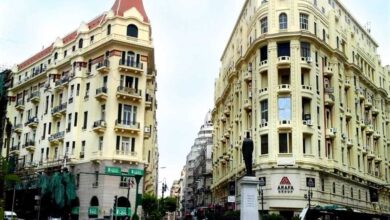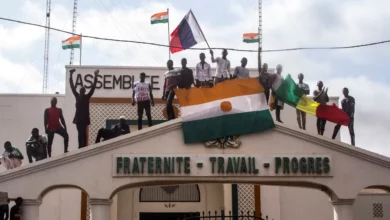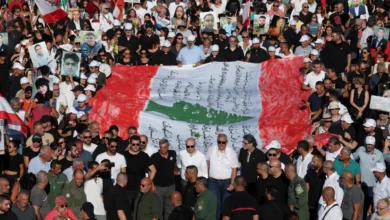
A little over a year after becoming a national symbol of unity, Tahrir Square has become a very lonely place.
Amid the complete absence of the state in the iconic square, those who chose to continue residing in it feel abandoned and isolated. The public often blames the square’s residents for harming the revolution that they say they’ve been camping out in the street for months to save.
Most of those who filled Tahrir last year to force then President Hosni Mubarak to step down have left, either believing that they have already won the battle or that Tahrir is no longer the way to advance the revolution.
A few remain there in small groups with different motivations, all believing that the square is the only place that yielded gains throughout the last year. Within these groups, there is little trust in the political process beyond the confines of the square.
In the grassless roundabout, Mekheimar Khamis Mekheimar, who was shot on 28 January 2011, dubbed the Friday of Anger, sits in front of his tent looking at a symbolic grave he made for himself.
The headstone reads, “I will not live without freedom, this is my grave, down with military rule.”
“We started our sit-in demanding our rights as the injured of the revolution, but when we were attacked, our demand became the fall of the military rule,” said Mekheimar.
The sit-in has entered its fourth month, sustained by less than a dozen mourners. It started on 18 November with a mass protest that Islamists mobilized against the supra-constitutional principles proposed by former deputy Prime Minister Ali al-Selmy. The bill was dubbed as an attempt by the military-backed government to impose the vision of the ruling Supreme Council of the Armed Forces on the state.
Following the protest, the sit-in held by the injured of the revolution to demand their rights was attacked by the police, instigating a bloody four-day standoff between police forces and protesters who came to the aid of those attacked.
Since then, the square filled up during days of violent confrontations and the occasional million man protests, after which people went back home. But Mekheimar and his group have stayed in the square since November.
With governments that have failed — over the course of a year — to implement any major reforms, and a parliamentary performance that revolutionary forces deem disappointing, those in the square express a loss of faith in the formal political channels, which are viewed by many as a legitimate replacement of the square.
“We became completely separated from parties and political powers because they are only interested in leadership and power,” says Mekheimar.
“Until the day I die I will keep calling for the demands of the revolution from the street and not in an office in a suit and tie,” he adds.
On the other side of the square, tempers were flaring in a tent set up in front of the Mugamma administrative building, which has been home for a few activists since November.
In the tent, a computer is set up with an internet connection, and a suit is hung up for one of the activists, a lawyer, to wear to work the next day.
Inside, the activists were planning the next day’s protest, which they dubbed “The Friday of Imposing the Peaceful Will,” hoping it would bring people back to the square for an open-ended sit-in that would last until the end of the military rule and the realization of the revolution’s reform demands.
“Tomorrow, there will be new political forces, and not those that burned themselves by engaging in politics before the revolution is over,” said activist Mostafa Aly, expressing a growing resentment in the square towards political forces that refuse to come to their rescue, leaving them to be mistaken for thugs by a large portion of the public.
“We are sleeping on the street and we’re expected to take orders from someone sitting in the comfort of their office?” said one activist as he stormed out of the tent, overcome by the frustration of the last few months.
For these activists, Tahrir Square is a safe haven from the hassle of politics that have proved evasive and unsatisfying to the revolutionary powers throughout the year.
Not everyone in Tahrir Square is sticking to the demands of the revolution though; some went there with demands that they can’t take anywhere else.
A small group known by the name of its leader, Dr. Omar, is camped out in Tahrir Square demanding the excavation of a tomb under building number 21 on Nour Foundation Street in the Zaytoun area, which, according to their interpretation of one Quranic verse, holds the name of the next president.
A Nasserist group that is in the process of founding a new party, “The Popular Nasserist Conference,” is also camped out in the square, promising a revolution inspired by former President Gamal Abdel Nasser.
Having set up a stage, complete with a big screen television showing nationalist songs and a photo gallery, every night in the square since the anniversary of the revolution on 25 January, the group raises the reform demands of the revolution, in addition to cancelling the Camp David peace treaty with Israel and expelling the Israeli Ambassador from Egypt.
Abandoned by political forces and the state since November, Tahrir residents function as a state within the state.
“Everyone here melted into one society where the good and the bad mix. Our society is not based on any discrimination, we only reject those that harm our interests and don’t abide by the peacefulness of the sit-in,” says Aly.
The people there say the square is subjected to attacks by “thugs” on a daily basis. The most recent severe attack happened last Thursday, when unknown assailants entered the square with machine guns. The protesters had to fend off the attack themselves, and reported it to authorities after capturing one of the weapons.
On occasion, men and women have attempted to “purge” the square of those there for non-revolutionary purposes. In February, one woman with a metal rod told Egypt Independent, “We are here to cleanse the square of the street people and keep it a space for the revolutionaries.”
Aly says that while the Tahrir community embraces anyone, including the widely rejected street vendors who outnumber the protesters in the square, it does reject infiltrators with malicious intentions.
Mekheimar says that the security forces’ presence in the square is limited to nightly patrols by military forces. He says, however, that they do little good, since the assailants that protesters hand in to security forces are released immediately after.
Ultras, hardcore football fans who joined protesters after their comrades were killed when violence broke out after a football match in February in Port Said, have burnt the tents of thugs that took refuge among Tahrir protesters.
The security vacuum is not only felt by those participating in the sit-in. The lack of traffic police, in addition to walls put up by the military in streets around the square, have led to daily surges in the square’s traffic that the sit-in is blamed for.
Columnist Fahmy Howeidy said that the complete absence of the state in the square, allowing it to become a hub for thugs and drug dealers who blend in with the protesters, is more than just an oversight. He reads it as an intentional effort by authorities to disfigure the symbol of Egypt’s revolution.
In an article he wrote earlier this month, Howeidy called the current state of Tahrir Square, “The worst ending to the noblest place in the Egyptian consciousness.”




